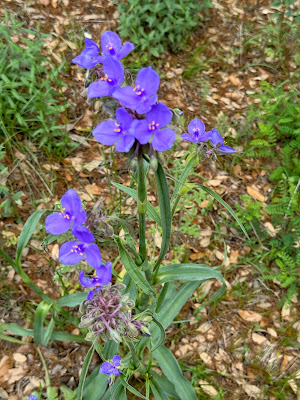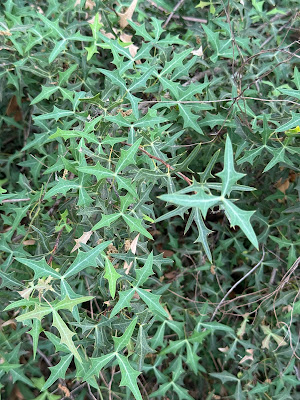We were fortunate enough to be invited to a high school and college friend's home near Austin to view the April 2024 total eclipse. Situated in the hills above Lake Travis and west of town, it was near the center path of the moon's shadow of the sun and total darkness would last almost 4 minutes. However, about a week before the eclipse and up to the day of the eclipse, the weather forecast was calling for several layers of clouds and even the chance of thundershowers at the time of totality. Just 2 days before the eclipse we decided to risk it and proceeded with our flight to Austin. We thought if nothing else, it would be an experience and maybe we'd get lucky. Having gone to school in Austin back in the 1970s, I recalled that early April was wildflower season and so we might get lucky there too. The weather was mostly clear as we landed and I could see fields south of the airport had a bluish cast which I recognized as masses of bluebonnets, Lupinus texensis, the official state flower of Texas since 1901. We were in luck.
 |
| Total Darkness Eclipse Viewing with 365 sunrise on all horizons |
After being mostly sunny the day before the eclipse, it was very cloudy the next morning as we drove to our eclipse viewing location. The sun would briefly appear for a few seconds between the low clouds giving occasional glimpses of the sun but often filtered through high clouds. Most of the time, we could look directly at the sun without the special viewing glasses. However, as the moon started passing in front of the sun, we were very lucky and had more and more cloud breaks. As totality began, we had a cloudless view of the sun. We saw the diamond ring - where the last rays of the sun passing through valleys on the moon create a bright diamond as the corona around the moon appears - and then we were plunged into total darkness. I noticed one planet and several red solar flares visible around the edges of the moon. We barely had time to take it all in and it was over....another view of the diamond ring on the opposite side of the moon and the sun started making its reappearance.
 |
| Hopefully you've seen better eclipse photos, but these are mine |
Our host, Brent Austin, had mentioned that we might be a little past the peak of the bluebonnets, but there were still a few remaining in a small field in front of his house. Before and after the eclipse, I set out to see what I could find. While many of the bluebonnets looked a little fried, I did find many other species of wildflowers as well as native bees and butterflies. I asked Brent if the flowers had been originally planted and he said that they were there when they bought the property 23 years ago and since then all they had done to maintain it was mow the field in the fall.
With more than 5000 species of wildflowers native to Texas, we were sure to find some, but were surprised at the variety in such a small area.
Here's some of the best we viewed in the wildflower meadow in front of the house.
 |
Wildflower meadow. The orange-flowered Indian Paintbrush, Castilleja indivisa, was at its peak here and along the Texas highways.
|
 |
A favorite of the pipevine butterfly, Indian Paintbrush, Castilleja indivia. These were in large masses along many of the roads and highways around Austin.
 | | This was my favorite flower, Asclepia asperula. A milkweed with a Grey Hairstreak butterfly feeding on it. |
|
This one was a bit of a surprise. At first I thought it was a small-flowered zinnia native to Mexico. But it turned out to be Blackfoot Daisy,
Melampodium leucanthum, which I've grown a few times in my garden. I thought it came from further north, but apparently it is also native to parts of Texas.
 |
This was a new one from me, Chamaesaracha edwardsiana, a member of the milkweed family native to the Edwards Plateau west of Austin.
|
Quarter-sized, Yellow Flax, Linium rigidum, hidden close to the ground but worth looking for.
I'm sure I saw this 40 years ago when I lived in Texas, but I never knew the name, Thelesperma filifolium. A member of the aster family that likes the poor soil and basic PH limestone soils of central Texas.
 |
| Not quite yet in bloom, Yucca rupiocola, native to the Edwards Plateau of Central Texas extending into northeastern Mexico. |
 |
| A native Phacelia maybe, P.a congesta. However, figuring out the species in Texas is just as difficult as in California since there are many. Let's just say this one was tall...and lovely. |
Not the best photos, but a cool plant, Texas Feathershank,
Schoenocaulon texanum. It's a perennial that likes poor soil.
 |
| Another plant that likes limestone, Mimosa borealis. |
Wildflowers I remember from 40 years ago
There also a number of flowers that I remember from when I lived in Texas in the 1970s and hadn't seen in decades. Here are a few:
Though we only saw a few scattered blooms at this site, I remember this one well from years ago. But I recall it in huge fields which we did see a few of in the distance, Coreposis lanceolata. There are several other species of native Coreposis growing here.
Cooperia pedunculata, (Texas) Hill Country Rain Lily. It is a bulb with 2 inch wide flowers. Pink margins show up the petals as they age.
 |
| Callirhoë involucrata, Winecups. This beautiful mallow grows throughout the state and I remember it from Houston as well as Austin. |
Tradescantia occidentalis, Spiderwart. The flowers are only open in the morning.
Tucked away between other plants was the short regal blue flowered skullcap, Scutellaria drummondii.
There were several different colors of short alliums in bloom. It is nearly impossible for me to identify the species since they all look so much alike.
An Erigeron, fleabane, but again nearly impossible for me to identify the species.
Some Surprises
There were a few plants and flowers that I was surprised to see.
Knowing that there are species that grow in the south, I should not have been surprised to find Blue-eyed grass, Sisyrinchium angustifolium . However, I mostly associate it with California wildflowers since it naturally grows with abandon to the point of being weedy on our home hillside. Just like the plants at home, the flowers are only fully open in the afternoon.
I was almost certain that this would turn out to be an invasive Cranesbill from Africa since they are everywhere in California, but it turns out that is a Texas native, Erodium texanum.
This shouldn't have been a huge surprise, but since it was near the street, I suspect it was planted. This is the Mexican form of eastern redbud,
Cercis canadensis var. mexicana. I grow this in my home garden and though this one was fully leafed out, mine was still in bloom. It has thicker, waxy and wavier leaves than other species and also more tolerant of dry conditions, but it does need some summer water.
Agarita,
Berberis trifolioata. It turns out it is a very common bush in the Edwards Plateau area of Texas Hill Country. I likely saw them 40 year ago, but didn't notice them. It looks very similar to some of the species native to the San Bernadino mountains, but shorter with larger leaves. Like the Southern California species, the leaves are sharp and it has red berries in summer.
This plant wasn't exactly a surprise since I recall seeing these over a decade ago growing on the live oak trees in San Antonio. This airplant was growing on a bush by the front door of my friend's house. It is
Tillandsia recurvata and grows on plants as far south as Argentina and Chile.
And of course there were still some Texas Bluebonnet.
Lupinus texensis, flowers remaining and many more setting seed for next year.































Wow, what a great day - how happy that you decided to go. The eclipse and all those glorious wildflowers!
ReplyDelete